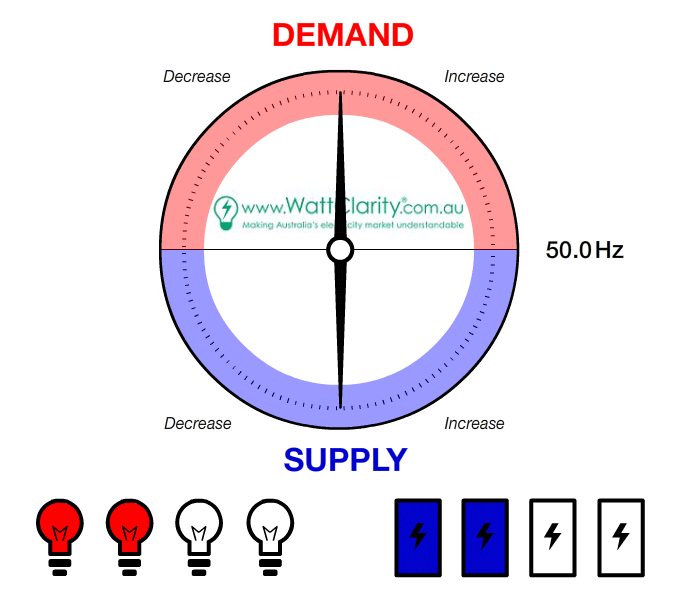On Thursday, March 23 2017 guest author Jonathon Dyson published the article ‘Let’s talk about FCAS’ – which has proved to be an article that has continued to be read, and linked to, since that time.
Along with the written explanation in that article, it also included this animation to illustrate the continuous operations of increments/decrements to supply/demand to keep frequency close to 50Hz in the NEM. (which has also been used in a variety of platforms since that time):

We worked with Jonathon to develop the GIF for illustrative purposes only – and it has proceeded since that time to be used in various platforms and presentations etc…
(A) FCAS Prices – hence Revenues
The way in which FCAS revenues are calculated is a little different from the way it works in the ENERGY market, as explained on this linked page.
(B) FCAS Cost recovery
The process for apportioning of FCAS costs has been changing over time, and so the description that was here has been shifted to a dedicated Glossary page here.
(C) Reporting about, and Commentary on, FCAS
In the annual Generator Statistical Digest (a WattClarity Deeper Insight publication) we have been reporting on calculated FCAS costs for many years.
| Specific Publication | Details (re FCAS costs) |
|---|---|
| GSD2019 |
The Generator Statistical Digest 2019 went some way to establishing some transparency in this respect by calculating these costs for all DUIDs for each month through calendar 2019. |
| GSD2020 |
The Generator Statistical Digest 2020 saw a similar approach to the GSD2019. |
| GSD2021 |
The Generator Statistical Digest 2021 saw a similar approach to the GSD2019. |
| GSD2022 |
The Generator Statistical Digest 2022 saw a similar approach to the GSD2019. |
| GSD2023 |
The Generator Statistical Digest 2023 saw an expansion to the coverage of statistical date for all units, leading to an expansion to 3 volumes and with FCAS-related data being mostly grouped into Volume 1, with: 1) FCAS cost apportioned to FCAS portfolio; but also 2) FCAS bidding and revenue included for the first time. The ‘B’ Page for each unit shows FCAS costs (for the 3 categories above) apportioned to each individual unit, and reporting on a monthly basis for calendar 2023. On 12th February 2024, Linton wrote about how the ‘GSD 2023 Uncovers Features in FCAS Enablement and Bidding’ … continuing Linton’s focus on the FCAS markets (particularly after the introduction of FFR. |
This reporting will continue to expand, over time
In terms of other articles on WattClarity, you might find these of use:
1) articles we have tagged with ‘FCAS’.
2) articles we have tagged about ‘frequency’.
(D) Other resources
In terms of other resources:
1) This AEMO ‘Guide to Ancillary Services in the NEM’ from April 2015 will also be useful.

